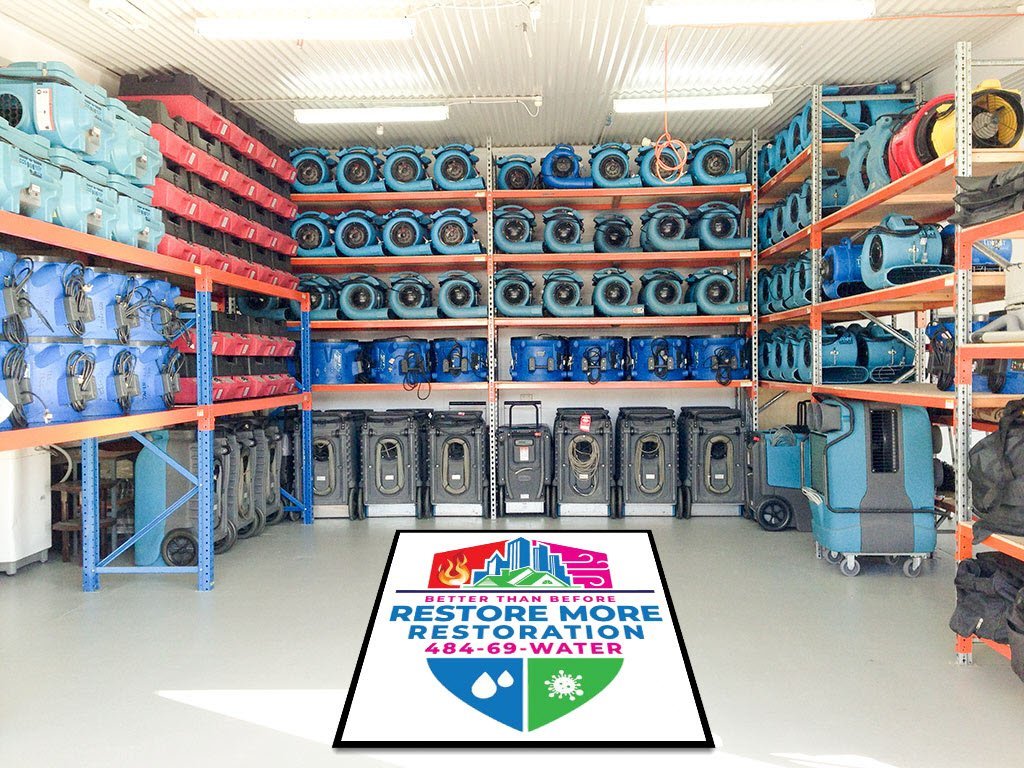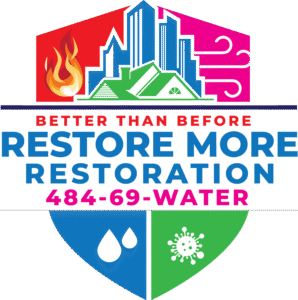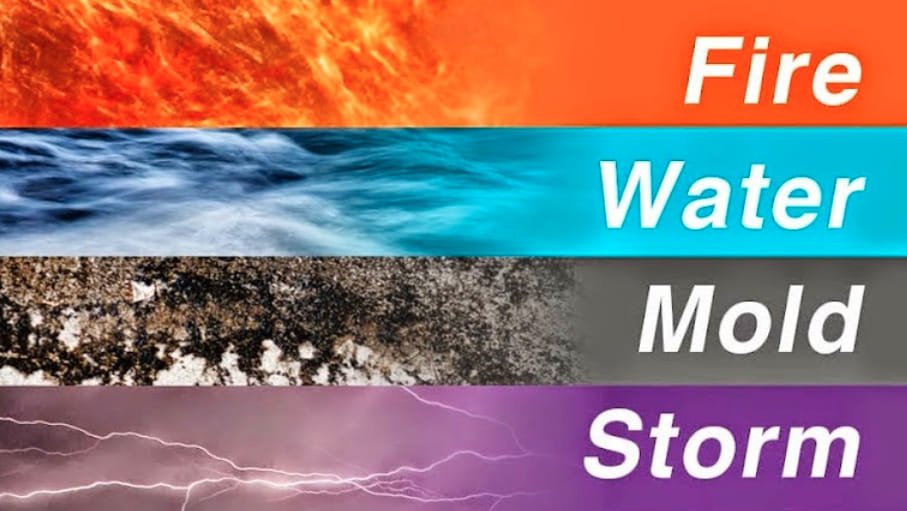Efficient Water Damage Restoration: Maximizing Speed, Quality, and Value
When water damage strikes your Garnet Valley home, efficiency in restoration becomes critical for minimizing costs, reducing disruption, and achieving quality outcomes that protect your property investment. Efficient water damage restoration combines advanced techniques, professional expertise, and strategic planning to deliver faster recovery times while maintaining the highest quality standards. Understanding what makes restoration efficient helps homeowners make informed decisions, work effectively with restoration professionals, and achieve the best possible outcomes when water damage affects their properties.
As water damage restoration experts serving Garnet Valley and Delaware County, we’ve refined our restoration processes to maximize efficiency while never compromising on quality or safety. Our partnership with RestoreMore365 has given us access to the latest restoration technologies and techniques that deliver superior results in less time, and we’re committed to helping our neighbors understand how efficient restoration can benefit their families and protect their homes.
Understanding Restoration Efficiency
Restoration efficiency encompasses multiple factors including response time, equipment utilization, process optimization, and resource management that work together to deliver faster, more cost-effective restoration outcomes. According to the Institute of Inspection, Cleaning and Restoration Certification, efficient restoration practices are essential for minimizing secondary damage and achieving optimal restoration results.
Key Components of Efficient Restoration
Rapid Response and Mobilization
Efficient restoration begins with rapid response that minimizes damage progression and creates optimal conditions for restoration work. Professional restoration companies maintain 24/7 emergency response capabilities with strategically positioned equipment and trained technicians who can respond to emergencies within hours rather than days.
Advanced Equipment and Technology
Modern restoration efficiency relies on advanced equipment that provides superior performance compared to traditional methods. This includes high-capacity extraction systems, industrial dehumidification equipment, thermal imaging technology, and wireless monitoring systems that accelerate restoration timelines while improving outcomes.
Systematic Process Optimization
Efficient restoration follows systematic processes that eliminate waste, reduce redundancy, and optimize resource utilization. These processes are based on industry best practices and continuous improvement methodologies that ensure consistent, predictable results across different restoration scenarios.
Integrated Service Delivery
Restoration efficiency benefits from integrated service delivery that combines multiple restoration disciplines under unified project management. This integration eliminates coordination delays, reduces communication gaps, and ensures that all restoration activities work together toward common objectives.
Benefits of Efficient Restoration
Reduced Restoration Timelines
Efficient restoration significantly reduces the time required to complete restoration projects, allowing families to return to their homes sooner and businesses to resume operations faster. Reduced timelines also minimize additional living expenses and business interruption costs that can add significantly to overall restoration expenses.
Lower Overall Costs
While efficient restoration may involve higher initial investment in advanced equipment and expertise, it typically results in lower overall costs through reduced labor time, faster completion, and prevention of secondary damage that would require additional restoration work.
Improved Quality Outcomes
Efficient restoration processes are designed to achieve superior quality outcomes through better equipment, systematic procedures, and continuous monitoring that ensures all restoration objectives are met consistently and completely.
Minimized Disruption
Efficient restoration minimizes disruption to daily life and business operations through faster completion, better coordination, and systematic approaches that reduce the impact of restoration activities on occupants and neighbors.
Advanced Restoration Technologies
High-Performance Water Extraction
Truck-Mounted Extraction Systems
Modern truck-mounted extraction systems provide significantly higher performance than portable equipment, removing larger volumes of water in less time while achieving better extraction rates from carpets, upholstery, and other materials. These systems can extract water at rates of 200+ gallons per minute compared to 10-20 gallons per minute for portable equipment.
Specialized Extraction Techniques
Advanced extraction techniques include submersible pumping for deep water removal, weighted extraction for improved carpet water removal, and injection extraction for cleaning and water removal in a single operation. These techniques reduce the number of restoration steps and accelerate overall restoration timelines.
Continuous Extraction Operations
Efficient restoration utilizes continuous extraction operations that maintain optimal moisture removal rates throughout the restoration process. This includes automated extraction systems that operate continuously and monitoring systems that optimize extraction performance based on real-time conditions.
Multi-Stage Extraction Processes
Professional restoration employs multi-stage extraction processes that remove different types of moisture through sequential operations. This includes initial bulk water removal, deep extraction for absorbed moisture, and final extraction for residual moisture that ensures complete water removal.
Industrial Drying and Dehumidification
High-Capacity Dehumidification Systems
Industrial dehumidification systems provide moisture removal rates that are 10-20 times higher than consumer equipment, dramatically reducing drying times while maintaining optimal humidity levels for effective restoration. These systems can remove 150+ pints of moisture per day compared to 10-20 pints for consumer dehumidifiers.
Strategic Air Movement Systems
Advanced air movement systems create optimal airflow patterns that maximize evaporation rates while minimizing energy consumption. These systems use computational fluid dynamics principles to position equipment for maximum effectiveness and efficiency.
Environmental Control Integration
Efficient restoration integrates environmental controls including temperature management, humidity control, and ventilation systems that create optimal drying conditions while maintaining indoor air quality and occupant comfort throughout the restoration process.
Automated Monitoring and Adjustment
Modern restoration equipment includes automated monitoring and adjustment capabilities that optimize drying performance based on real-time environmental conditions. This automation ensures consistent performance while reducing labor requirements and improving outcomes.
Moisture Detection and Monitoring
Thermal Imaging Technology
Thermal imaging cameras provide non-invasive moisture detection that identifies hidden moisture in walls, ceilings, and floors without requiring destructive investigation. This technology accelerates damage assessment while ensuring that all moisture is identified and addressed during restoration.
Wireless Monitoring Systems
Wireless monitoring systems provide continuous moisture monitoring throughout the restoration process, allowing technicians to track progress remotely and make real-time adjustments to optimize drying performance. These systems reduce labor requirements while improving restoration outcomes.
Psychrometric Analysis
Advanced psychrometric analysis uses environmental data to optimize drying conditions and predict restoration timelines with greater accuracy. This analysis ensures that drying equipment is properly sized and positioned for maximum effectiveness and efficiency.
Data-Driven Decision Making
Modern restoration relies on data-driven decision making that uses moisture readings, environmental conditions, and equipment performance data to optimize restoration strategies and ensure predictable, consistent outcomes across different restoration scenarios.
Process Optimization Strategies
Systematic Damage Assessment
Comprehensive Initial Assessment
Efficient restoration begins with comprehensive initial assessment that identifies all damage, determines restoration requirements, and develops optimal restoration strategies. This assessment uses advanced detection equipment and systematic evaluation procedures that ensure nothing is missed while minimizing assessment time.
Prioritized Restoration Planning
Restoration planning prioritizes activities based on damage severity, safety requirements, and restoration efficiency to ensure that critical activities are completed first while optimizing overall restoration timelines. This planning considers resource availability, equipment requirements, and coordination needs.
Integrated Scope Development
Efficient restoration develops integrated scopes that combine multiple restoration activities under unified project management. This integration eliminates coordination delays and ensures that all restoration work proceeds systematically toward completion.
Continuous Assessment Updates
Restoration assessment continues throughout the restoration process with regular updates that identify new damage, assess restoration progress, and adjust restoration strategies as needed. This continuous assessment ensures that restoration remains on track while adapting to changing conditions.
Coordinated Service Delivery
Multi-Discipline Integration
Efficient restoration integrates multiple restoration disciplines including water extraction, structural drying, cleaning, and reconstruction under unified project management. This integration ensures that all activities work together efficiently while eliminating coordination delays and communication gaps.
Simultaneous Operation Coordination
Advanced restoration coordination allows multiple restoration activities to proceed simultaneously when possible, reducing overall restoration timelines while maintaining quality and safety standards. This coordination requires careful planning and experienced project management.
Resource Optimization
Efficient restoration optimizes resource utilization through strategic equipment deployment, skilled technician assignment, and material management that ensures all resources are used effectively while minimizing waste and redundancy.
Quality Control Integration
Quality control is integrated throughout the restoration process rather than being limited to final inspection. This integration ensures that quality standards are maintained throughout restoration while identifying and correcting issues before they affect final outcomes.
Technology-Enhanced Efficiency
Digital Documentation Systems
Digital documentation systems streamline damage assessment, progress tracking, and quality verification while providing real-time access to restoration information for all stakeholders. These systems reduce administrative time while improving communication and coordination.
Mobile Technology Integration
Mobile technology allows restoration technicians to access information, update progress, and coordinate activities from the field, reducing travel time and improving communication while ensuring that all stakeholders have current information about restoration progress.
Automated Reporting Systems
Automated reporting systems generate progress reports, moisture readings, and quality documentation automatically, reducing administrative burden while ensuring that all required documentation is complete and accurate.
Cloud-Based Project Management
Cloud-based project management systems provide real-time access to restoration information for homeowners, insurance companies, and restoration teams, improving communication while reducing coordination time and ensuring that all stakeholders remain informed throughout restoration.
Quality Assurance and Efficiency Balance
Maintaining Quality Standards
Industry Standard Compliance
Efficient restoration maintains compliance with industry standards including IICRC guidelines, safety regulations, and quality requirements while optimizing processes for maximum efficiency. This compliance ensures that efficiency improvements never compromise quality or safety.
Systematic Quality Control
Quality control systems are integrated throughout efficient restoration processes rather than being limited to final inspection. This systematic approach identifies and corrects quality issues early while maintaining restoration efficiency and preventing rework.
Performance Verification
Efficient restoration includes systematic performance verification that ensures all restoration objectives are met while maintaining optimal timelines. This verification uses objective measurements and standardized procedures that provide consistent, reliable quality assessment.
Continuous Improvement
Restoration efficiency benefits from continuous improvement processes that analyze restoration performance, identify optimization opportunities, and implement improvements that enhance both efficiency and quality over time.
Balancing Speed and Thoroughness
Risk-Based Prioritization
Efficient restoration uses risk-based prioritization that focuses resources on the most critical restoration activities while ensuring that all necessary work is completed thoroughly. This prioritization optimizes restoration timelines while maintaining comprehensive restoration coverage.
Parallel Processing Opportunities
Advanced restoration planning identifies opportunities for parallel processing that allows multiple restoration activities to proceed simultaneously without compromising quality or safety. This parallel processing can significantly reduce overall restoration timelines.
Quality Gate Implementation
Quality gates are implemented at critical restoration milestones to ensure that quality standards are met before proceeding to subsequent restoration phases. These gates maintain quality while preventing rework that would compromise restoration efficiency.
Adaptive Process Management
Efficient restoration uses adaptive process management that adjusts restoration strategies based on real-time conditions and progress assessment. This adaptability ensures optimal efficiency while maintaining quality standards throughout changing restoration conditions.
Cost-Effectiveness and Value Optimization
Direct Cost Reduction Strategies
Equipment Efficiency Optimization
Advanced restoration equipment provides superior performance per dollar invested, reducing overall restoration costs through faster completion, lower energy consumption, and better outcomes that eliminate the need for additional restoration work.
Labor Productivity Enhancement
Efficient restoration processes enhance labor productivity through better training, advanced equipment, systematic procedures, and technology integration that allows technicians to accomplish more work in less time while maintaining quality standards.
Material Waste Reduction
Systematic restoration processes reduce material waste through better planning, precise material estimation, and efficient utilization that minimizes excess materials while ensuring that all restoration requirements are met completely.



